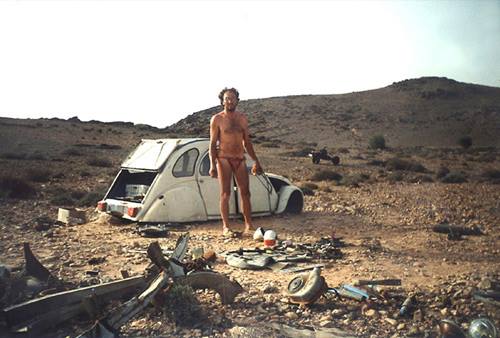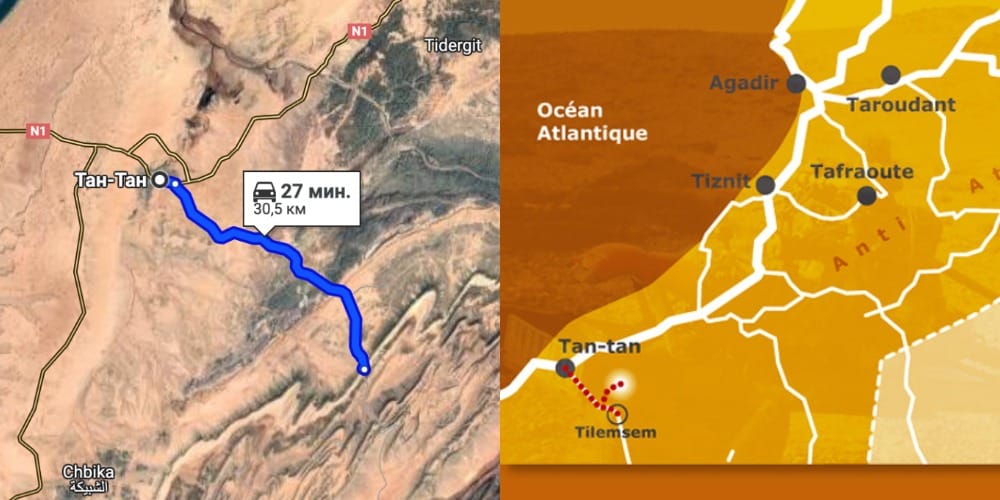There is a popular story on the Internet about how in 1993, a French electrician’s car broke down while traveling through the desert in Morocco and he converted it into a motorcycle to save himself. We decided to check if this story is true.
The amazing story of Emile Leray, who miraculously escaped from the desert thanks to the fact that he was able to convert his Citroën 2CV into a motorcycle, is told popular science And entertaining resources, as well as portals about cars And extreme vacation. Social network users (“VKontakte", X, Facebook, Instagram, Telegram) and blogging platforms (“Peekaboo", LiveJournal) share on their pages a story about the adventures of an enterprising Frenchman. Most publications contain photographs of Leray in the desert with his amazing invention in the background, as well as photographs of the stages of converting a car into a motorcycle. Some posts specify that Leray's only tools were wrenches, pliers, a hammer and a hacksaw. Interestingly, after the Frenchman was able to get out, the Moroccan police allegedly fined him for driving an unregistered vehicle.
The story of Emile Leray is definitely not just a fictitious internet story. Many posts about her contain photo reports of converting a car into a motorcycle. Leray himself is happy to give away interview journalists, telling, why he was stuck in the middle of the desert, how he came up with the idea of converting a car into a motorcycle and how he managed to do it.

Despite the fact that everything happened relatively recently (in 1993), and Leray willingly retells this story and shows his invention, many Internet users have doubts that the story is true. Firstly, Leray claims that he rebuilt his car for 12 days, but it is unclear how he had enough food and water for such a long period. Secondly, users wonder why he could not fix his car if he had the skills and tools to assemble a new vehicle. Thirdly, some users believe that the set of tools supposedly available to Leray would not be enough to completely disassemble the car and reassemble the motorcycle. And finally, a series of photographs of Leray in the desert looks very professional, as if someone else was present there. Although he could technically film himself by composing a frame and setting a timer, users doubt that a person on the verge of survival would do this.
In addition, according to Internet users, it would be easier for Lera to get to civilization on foot than to remodel a car.
On its website (at the time of writing this analysis is not available, but has been preserved archival copy) Leray posted a map of his route: he was traveling from the Moroccan Tan-Tan to the border of Western Sahara, where he was turned around by the military (the territory was closed to travel due to the armed conflict between Morocco and Western Sahara). He went back, but then decided to go around the border outpost through off-road terrain, where he hit the fatal stone. The distance between Tan-Tan and the point where Leray was deployed is about 30 km (27 minutes by car or seven hours on foot). Judging by the map on his website, the distance he drove from the border post was barely half that distance. It turns out that Leray really had no need to spend so much time and effort converting the car into a motorcycle. To survive, it was enough to walk several hours to a populated area. The journey through the desert would probably not be very easy or pleasant, but it would be a less risky step than spending 12 days and all of his food and water supplies on an enterprise that might not be successful.

In 2015, the hosts of the American show “Mythbusters” Jamie Hyneman and Adam Savage decided check, is it actually possible to convert a Citroën 2CV into a motorcycle under the conditions Leray describes? They took an old car of the same model, the same set of tools and went to the desert area near San Francisco. Despite the doubts expressed by some Internet users, they managed to disassemble the car surprisingly easily; they hardly even needed tools. However, when it came to assembling the new vehicle, the show's hosts were stumped. In the end they succeeded build something like a motorcycle and even set it in motion, but it was not possible to ride the invention even hundreds of meters, since it kept falling over on its side.
Heineman and Savage did not stop there and decided to do more one try, but this time we don’t just assemble a motorcycle on a whim, but rely on photographs of Leray’s motorcycle. However, she failed success: both presenters managed to ride the improved motorcycle a little further than on the first prototype, but very little.
This is not the only time a Citroën 2CV has been converted into a motorcycle. For example, Italian Franco Grosso, owner of a workshop specializing in this brand of cars, collected motorcycle made from spare parts of an old 2CV. However, he did not set himself such restrictions as Leray’s, so, on the one hand, it is not surprising that he came up with a more successful prototype, and on the other hand, his result can hardly serve as confirmation of the veracity of Leray’s story. Amazing exhibits, such as a motorcycle made from car parts, are one of the advertising techniques of Grosso’s workshop.
Be that as it may, the Frenchman apparently enjoyed rebuilding Citroën cars so much that in 2006 he did from one of them a boat to cross the Senegal River, and then made a film about it and posted it on his YouTube channel. It is possible that turning the CV2 into a motorcycle was also a planned event, to which Leray decided to add charm with an action-packed story about survival in the desert.
Thus, apparently, Emile Leray actually assembled a motorcycle from spare parts of his car. Many details of his history (for example, when the motorcycle was assembled and the set of tools used) cannot be verified, since the only source of information is Leray himself. As for his motivation, he most likely embellished this part somewhat. Judging by the route he took, he had no need for a vehicle to get to civilization from the accident site - this distance can be covered quite quickly on foot. In addition, the carefully filmed process of reassembling the car into a motorcycle and Leray, posing in shorts in front of his creation, also give reason to believe that the Frenchman was not at all trying to survive, suffering from hunger and heat. Most likely, if the motorcycle was indeed assembled in the desert, this was Leray's original plan.
Cover photo: Сhameau d'acier
Read on the topic:
- The Times. A Citron, a saw… et voilà, I have a bike
- Is the story true about a resident of Taganrog who bought an old car in the USA for $9,000, and after repairs sold it for $80,000?
- Is it true that the Harley-Davidson company was founded by Russian emigrants Kharlamov and Davydov?
If you find a spelling or grammatical error, please let us know by highlighting the error text and clicking Ctrl+Enter.






